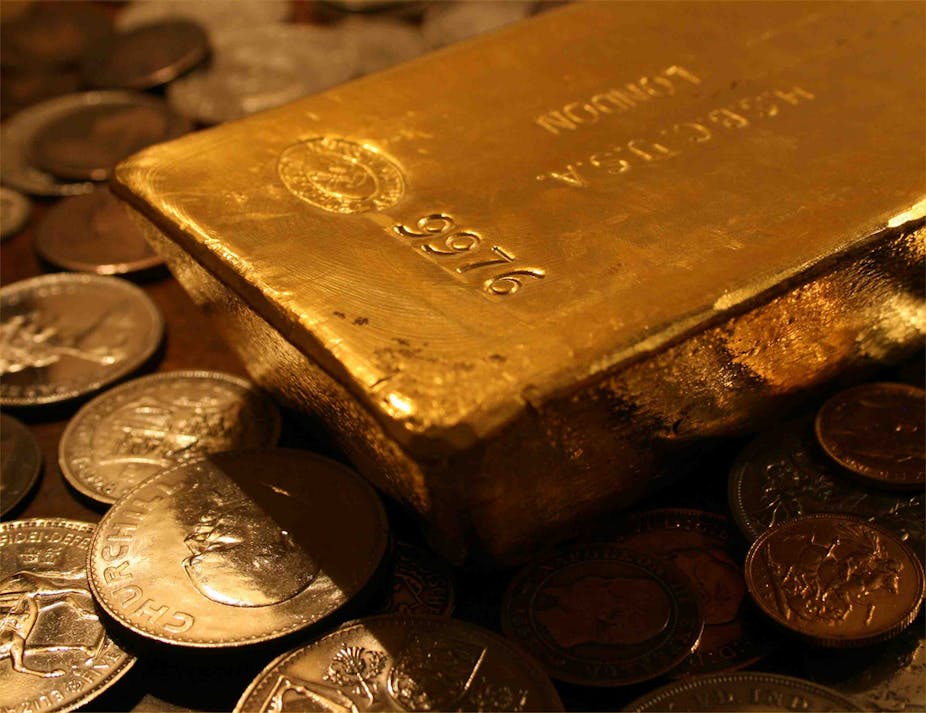It has been a turbulent time for the gold market. The past two days of trading have been particularly volatile, with gold prices recording the sharpest two-day drop in 30 years .
The severity of the fall has led market commentators to suggest the gold price is now entering a bear market phase, with further falls expected in the future. A key explanation is that the outlook for the world economy is improving, and so investors are pulling out of safe haven investments and looking for investments that yield better returns. Furthermore, the possibility of Cyprus selling some of its gold reserves could have exacerbated this effect.
Perhaps the most important question is whether gold prices will continue to fall. There have been three recent falls in gold prices over the period from 2011 to the present. Reference to recent London PM gold fixings provides some insight into the volatility of gold prices over the past two to three years. While gold prices rose rapidly prior to 2011, there were four peaks in the reported London gold price fixing. The spot price reached US$1895 on the 5th and 6th of September in 2011; US$1795 on the 8th of November that year; US$1781 on February 28 2012 and US$1791.75 on October 4 2012. Spot prices have consistently fallen, up until the last couple of days when the prices plunged to US$1395 on April 15.
The fall in the gold price will also affect the unit price of exchange traded funds (ETFs), which hold gold and derivative contracts that are written on gold. Gold ETFs tend to hold gold bullion or take positions in derivative contracts written on gold, so if investors are no longer interested in holding gold as an investment, they will sell the units in gold ETFs as well as physical gold. These direct trades, along with arbitrage trading, will tend to drive down the unit price of gold EFTs and gold derivatives until they reflect the fall in the underlying gold price.
But it is difficult to predict whether the price of gold will continue to fall. To some extent, the price of gold moves with crude oil and other commodities. For example, the correlation coefficient between the monthly rate of change in gold price and crude oil price is around 0.20. This is not particularly large, but it does suggest that there is some common movement from month to month. There is also some evidence of longer term links between these two commodities. The crude oil price has been trading around US$95 per barrel over the past couple of years and gold has been trading around US$1650 or so, except for recent months. While we often see graphs of gold prices rising or falling over selected periods it is very difficult to predict where prices will go from day to day. This tendency for prices to wander almost aimlessly over time is often referred to as a random walk, though the gold price movements of the last couple of days look more like considerable stumbles. Regardless, it is very difficult to know which way commodity prices will move over the next few months.
Recent news from China suggests that there could be a slowing in the demand for commodities in the coming year. Perhaps commodity prices generally will fall with the expectation that demand will not be so good in the near future. This would exert downward pressure on the gold price.
Yet, while global consumer sentiment is increasing of late, as measured by the University of Michigan Consumer Sentiment Index and by the Conference Board Consumer Confidence Index, consumer confidence is still well below the levels achieved prior to the global financial crisis. This lack of global confidence will tend to support gold prices because of the safe haven that gold provides for investors.
Is gold still a safe haven commodity? Gold can still be easily bought and sold. It is difficult to destroy and can be stored relatively safely and at quite low cost. These safe haven characteristics of gold have not changed, and there is still much to be concerned about with European debt and political instability across the world. The problem for safe haven assets such as gold is that they do not generate income. If prices are falling, then the gold investor is making losses; gold investments have been generating losses for some months now.
With recent slowing in the Chinese economy, the fall in demand for commodities generally will tend to further depress prices of commodities such as gold. This poses a problem for investors, who see growing equity markets around the world. They have invested in a metal that is safely stored in a bank vault, which is currently generating losses with each fall in the gold price. At some stage, they must decide to cut their losses on gold and invest in more profitable alternatives. Perhaps the current dramatic falls in the gold prices reflects a change in investor expectations.
Since publication, this story has been revised to reflect the following correction: gold prices recorded their sharpest two-day drop in 30 years. This error was made by the editor.

